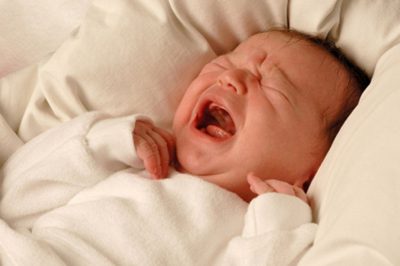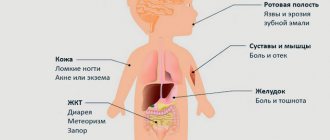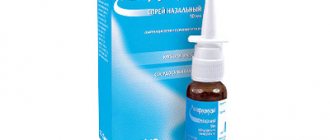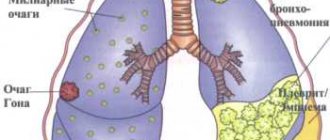( 9 ratings, average: 4.56 out of 5)
Adenoids are immune tissue that produces immunoglobulins that are directly involved in the normal development of the child’s body.
Negative effects: colds, infections, allergies provoke the growth of adenoids and the inflammatory process. Such factors indicate that the body is exposed to allergens and there are malfunctions in the immune system.
Performing a protective function, adenoids neutralize the negative influence of the external environment on the child’s body. As a result, mucous discharge occurs and the adenoids swell, which interferes with nasal breathing.
Adenoids can have varying degrees of growth.
- I degree: during the daytime the child’s breathing is nasal, free and easy. At night, when the adenoids slightly increase in volume, breathing becomes difficult and snoring appears.
- II and III degrees: the child breathes through his mouth throughout the day. At night, snoring occurs due to an increase in the volume of the adenoids and obstruction of the posterior sections of the nose.
Symptoms of adenoids in a child 1-3 years old
The disease progresses sluggishly, without sharp and obvious symptoms, this can somewhat relax the parents’ vigilance and may even give the impression that the child is healthy. However, you should not be superficial about adenoids and their manifestations.
- The first warning sign is frequent colds.
- The child complains of frequent runny noses, which over time can transform into chronic rhinitis.
- The child experiences restless sleep, accompanied by snoring and even attacks of suffocation. As a result of poor sleep, the child does not regain strength and is lethargic and inactive during the day.
- Due to the limited mobility of the soft palate, the sound is formed incorrectly, and the child’s speech turns into an illegible set of sounds.
- If the disease has become chronic, changes in the facial skeleton may be observed, as the jaw is in a constantly sagging position. As a result, the lower jaw acquires a narrow and elongated shape, the bite is also formed in an incorrect way, and the hard palate in the upper jaw becomes high; in medicine, this phenomenon is called a “Gothic” palate.
- The chest is formed incorrectly, since the child breathes for a long time through the mouth and not through the nose.
- The child develops a morning cough and hearing deteriorates.
Causes and risk factors
Children under seven years of age are often susceptible to pathology. At the age of ten, the lymphoid tissue begins to sclerose, which is why the disease occurs much less frequently. Adults whose children get sick more than four times a year should be prepared for surgery.
The tonsil increases in volume because lymphoid tissue has the ability to grow.
The formation of hypertrophic processes is associated with the following reasons::
- Increased susceptibility of the immune system to all kinds of allergens - citrus fruits, chocolate, pet hair. Children who suffer from asthma or nasal polyponosis are at risk;
- Frequent colds (ARVI, flu);
- Artificial feeding.
- Incorrectly selected diet high in carbohydrates. This is a direct path to dysbiosis (disruption of the gastrointestinal tract).
- Deficiency of microelements and vitamins.
- The presence of chronic adenoiditis in children. Children suffering from frequent sore throats, sinusitis, pharyngitis;
- Past diseases such as: rickets, vasculitis, lupus;
- Bad ecology;
- Due to impaired immune function - diathesis.
Symptoms of adenoiditis appear a couple of days after hypothermia or great stress. Adults often notice enlarged tonsils at the time of a cold. During a period when the immune system is weakened, microbes become active and multiply rapidly, after which the first signs of illness appear.
Getting rid of a chronic infection is not easy, since the bacterial flora collects in the gaps and waits for its opportunity. As a rule, the process of exacerbation occurs after prolonged exposure to the cold, or through contact with a carrier of colds.
Adenoid removal – pros and cons
The nasopharyngeal tonsils actively participate in immune reactions and the formation of the body's defense against viruses, which is why most doctors practice the use of conservative treatment methods.
In addition, it is difficult to completely remove the adenoids of a small child. And given the ability of the adenoids to recover, after surgery, after some time, the situation may repeat. There are cases where a child had to undergo repeated surgery three or even four times.
However, surgical treatment of adenoids cannot be avoided in cases where conservative treatment has exhausted itself and has not led to the desired result - recovery.
It is important to remember that the period of functioning of the adenoids occurs before the age of 11-14 years. Subsequently, having completed the appropriate amount of work for them, the nasopharyngeal tonsils disappear.
In any case, you should not agree to remove the adenoids. It is necessary to consult additionally with several doctors. If the diagnosis is confirmed, you should undergo several courses of conservative treatment, and if the symptoms of enlarged adenoids do not disappear, use the last resort method - surgery.
How to treat adenoids in children under one year, 2 or 3 years old
Treatment of adenoids is carried out in several stages. Before prescribing the necessary course of treatment, you should consult an otolaryngologist who can correctly assess the situation.
Modern medicine offers several possible treatment options for adenoids, however, each of them involves eliminating the source of infection, stopping inflammation and stopping the focus of bacteria causing the disease.
Regarding treatment methods:
- Drug therapy. Saline solutions are used to rinse the nose and remove mucus. Drugs that have antiseptic properties are used to dry out the nasal mucosa. In addition, drugs are needed to eliminate swelling and inflammation.
- Laser therapy. This method is aimed at eliminating swelling and inflammation of the adenoid tissue. The nasal mucosa dries out and the number of pathogenic microbes decreases. For a full course of treatment, 10 procedures are required.
- Homeopathy. This method is based exclusively on natural preparations, however, its disadvantage is the duration of the course of treatment - several months.
- Nasal rinsing
How to independently determine the disease?
A little person spends most of his life with his parents. Therefore, they should be the ones to notice the first signs of the inflammatory process. How to recognize adenoids in your own child?
The following manifestations should be paid attention to first:
- the baby spends most of the time with his mouth open;
- the act of breathing is carried out through the mouth and not through the nose;
- Inflammatory diseases of the ears and upper respiratory tract occur very often;

breathing is difficult;- prolonged runny nose, which does not respond well to drug therapy;
- nasal discharge (mucous) leads to irritation of the skin around the nasal passages;
- the child has difficulty concentrating;
- periodic pain in the larynx;
- constant complaints of headache;
- the lack of oxygen supply affects the child’s behavior: he becomes capricious, often cries for no reason, sleeps poorly, and is lethargic throughout the day;
- speech may become slurred;
- hearing problems may occur;
- frequent inflammatory diseases of the middle ear;
- cervical lymph nodes are inflamed, painful on palpation and enlarged.
Very often, adenoiditis occurs between the ages of 3 and 12 years. The disease can cause a lot of trouble for both the child and his parents. Therefore, at the first suspicion of inflammation, it is necessary to contact an ENT doctor for advice and a correct diagnosis.
Symptoms depending on the stage of the disease
Vegetation of adenoids in a child is usually distinguished by stages. The symptoms of the inflammatory process directly depend on the degree of growth of the adenoids. (Table 1). So, there are three stages of the inflammatory process:
- first – vegetative growths are insignificant;
- second – further growth of inflammatory tissue occurs;
- third, adenoids in a child can completely block the lumen of the nasopharynx.
Table 1 - Manifestations of adenoids at different stages
| First degree |
|
| Second degree |
|
| Third degree |
|
Inflammation of the tonsils in infants
The proliferation of lymphoid tissue in newborns and infants occurs much less frequently than in children from 3 to 12 years old.
As a rule, the cause of the appearance of adenoid vegetations is the inflammatory process in the nasopharynx and colds.
Adenoids have symptoms in children under one year old, which can be represented as follows:

the breathing process is difficult;- breastfeeding and bottle feeding causes difficulty and, as a result, underfeeding and weight loss, lag in physical development;
- At night the child sleeps poorly, often wakes up, sleep is superficial;
- saliva may leak from the corners of the mouth;
- the baby's behavior is restless;
- Weeping eczema may form under the nose (the result of constant nasal discharge);
- ominous symptom: anemia and asthmatic attacks.
Traditional treatment of adenoids in children
1.Nasal rinsing
Before starting the procedure, you should clear your nose of mucus. It is necessary to free the nose in stages, each half separately. Rinsing the nose will help eliminate secretions accumulated on the adenoids.
Procedure diagram:
- place the child on his tummy, with his head slightly tilted forward;
- the syringe must be inserted into one half of the nose perpendicular to the face to a depth of no more than 1 cm;
- the solution should be administered in small portions, gradually increasing the jet pressure.
To reduce adenoids and eliminate the inflammatory process, you can use:
- infusion of horsetail. Pour 1 teaspoon of herb with a glass of boiling water and leave for no more than five minutes. Cool and rinse your nose.
- herbal decoction: oak bark, eucalyptus, St. John's wort. Proportion: 5-6 grams of collection per 200 ml of water. Boil for five minutes, cool and apply.
- sea salt solution. Proportion: for 1 glass of water, 0.5 teaspoon of sea salt.
- Chamomile decoction with honey. Proportion: for 1 glass of water 5-6 grams of chamomile, 0.5 teaspoon of honey. Add honey to the prepared and not hot decoction.
- green tea. Proportion: for 1 glass of hot water, 1 teaspoon of tea. Leave for 15-20 minutes, rinse your nose.
2. Nasal drops
- fresh beet juice. The number of drops depends on the age of the child: from 4 to 8 drops. Instill after rinsing the nose.
- decoction of duckweed. Proportion: 2 tablespoons of herb per 0.5 glass of water, boil for five minutes, strain, drop in nose after rinsing.
- infusion of green walnut skin. Proportion: for 1 glass of water, 2 tablespoons of chopped nut peel. Pour in water, bring to a boil and leave for an hour. Strain, instill 3-4 drops no more than 4 times a day.
You can also use a plastic inhaler and breathe in the vapors of eucalyptus, calendula and soda. The ingredients can be mixed or used separately. One inhalation requires 0.5 teaspoon of the mixture. The duration of the procedure is from 5 to 10 minutes, frequency – 1-2 times a day.
Before using traditional methods of treatment, it is important to check whether the child is allergic to the components, and also consult a doctor.
The reasons for such differences in adenoid vegetation at the three-year mark of development of the child’s body

For what reason does such a dividing course of adenoid hyperplasia occur in children? And why does such a pathogenic picture with adenoids occur precisely in the 3rd year of a child’s life?
The origins of the answer lie far from the age we are considering (3 years). The laying of the future homeostasis (health) of a person begins at the genetic-molecular (cellular) level (with the division of female and male cells, which give the start to future life). The hereditary factor plays a big role here. Not perception (strong immunity) or, conversely, a tendency to adenomicrobial, viral, bacterial invasion.
And in the first trimester of pregnancy, which is especially important for the baby. In this phase of the formation of organic systems, nature “pays increased attention” to the immune system and the proper creation of nasopharyngeal lymphoid glands. After all, these are the primary, natural barriers against that same harmful and evil adenoid hyperplasia that lies in wait for older children.
Related articles Beware! Temperature in adenoids
But the three-year age limit, unfortunately, and for still unclear evidentiary morphological and physiological reasons, is assessed by pediatrics as the most vulnerable age for adenoviral intoxication. Children 1, 2 years of age, after the third year (4-10 years) suffer much less from adenoid growths. Perhaps the stumbling block, according to leading experts in otolaryngology and pediatrics, is still in the incomplete process of formation of the immune system, its peripheral organic sectors, which include the lymphoid glands of the nasopharynx.
In conclusion of the discussion of topics of interest to parents of 3-year-old children with adenoids, the topics “ Symptoms of adenoids in a 3-year-old child” and “ Inflammation of the adenoids in children, symptoms”, we emphasize the main leitmotifs.
The difference in the manifestation of inflammation of the adenoids in children (3 years old) is an established fact in the practice of pediatric visceral otolaryngology and pediatrics. Such cases are observed everywhere. And such circumstances depend on the child’s innate immunity, on the tendency to acquired pathologies (the formation of strong or weak resistance) to colds and infectious infestations.
Take this indisputable advice! Preventive measures, preventive washing and rinsing with healing solutions are considered effective resistance. Timely instillation, on the recommendation of the supervising ENT doctor, with anthranasal drops, lubrication of the nasal cavities with medicinal ointments.
Regularly carry out warming wellness procedures - ultraviolet and LED irradiation, halotherapy (visiting salt rooms). Intensively use climatic therapy (water procedures with sea water, air “baths”, hardening in the summer in mountain children's sanatoriums).
For parents, the 3rd year of their children’s life bears increased responsibility and concern for the baby’s health. Especially if the child already shows weakness in respiration, often catches colds, and is weak by nature. Be extremely careful and careful, and the 3-year period will pass without pathogenic adenoids!
Cost of surgery to remove adenoids in children
If there is a need for surgery, it is important to remember that there are certain favorable periods for removing adenoids. It is better not to perform the operation during the child’s growth period, when the nasopharynx is growing and developing. The optimal period for adenotomy is the period when the child’s growth slows down, namely from 5 to 6 years, from 9 to 10 years and after 13-14 years.
Many people have fresh memories of having their adenoids removed without anesthesia. However, modern medicine, which uses endoscopic equipment, offers a completely painless method of performing surgery under general anesthesia.
The cost of such an operation will be slightly higher than adenotomy under local anesthesia. This is explained by the fact that not only the surgeon, but also the operating nurse and anesthesiologist take part in the operation. Also, the operation requires the use of modern equipment.










